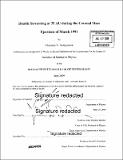Double streaming at 35 AU during the coronal mass ejections of March 1991
Author(s)
Nampaisarn, Thanasin V
DownloadFull printable version (9.575Mb)
Other Contributors
Massachusetts Institute of Technology. Department of Physics.
Advisor
John Winston Belcher.
Terms of use
Metadata
Show full item recordAbstract
We analyze data associated with the coronal mass ejections of March 1991, with emphasis on a remarkable double-streaming proton event observed at 35 AU. The plasma data used in our analysis were collected by three spacecraft: Voyager 2 near 35 AU, Ulysses near 3 AU, and IMP-8 at 1 AU. The observations of the same CME events by three spacecraft over such a wide range of radii gives insight into the evolution of CMEs as they propagate from the Sun to 1 AU and then into the outer heliosphere. Of the many characteristics observed, we are especially interested in the double-streaming proton events seen at Voyager 2 in June 1991 over a two day period. Such pronounced double-streaming has not previously been reported to be a feature of CMEs at any distance, much less at distances of 35 AU, with its 120 day transit time from the Sun. The double streaming events show a remarkably large separation between the two peaks that is close to the Alfvén speed and much greater than the thermal spread of either peak. These double streaming events were followed a day later by a large scale polarity reversal in the interplanetary magnetic field at Voyager 2. This reversal is thought to be a site of magnetic reconnection, where energy in the field is being converted into particle energy. We speculate that the free energy involved in the earlier double streaming events is somehow related to this magnetic reconnection process, although we have found as yet no direct causal connection.
Description
Thesis (S.B.)--Massachusetts Institute of Technology, Dept. of Physics, 2009. Includes bibliographical references (leaf 52) and index.
Date issued
2009Department
Massachusetts Institute of Technology. Department of PhysicsPublisher
Massachusetts Institute of Technology
Keywords
Physics.